Cloud Foundry介绍
Cloud Foundry是业界第一个开源的PaaS,号称工业界唯一的云应用平台。
本文重点讲述Cloud Foundry在阿里云上的部署方案,对于Cloud Foundry介绍的部分简单略过。
Cloud Foundry解决了什么问题?
关键词:PaaS、开源
Cloud Foundry是一种平台即服务(PaaS),兼容多种基础设施云,提供多种开发框架和应用服务。目前开源支持部署Cloud Foundry的基础设施云包括AWS、Azure、OpenStack等等,CF在开发框架上支持Java、.NET、Ruby等等,有很强的灵活性。
IaaS帮助开发者和客户解决了基础设施的问题,Cloud Foundry作为PaaS,在云上让开发者的视角更高,开发者只需要关注应用和数据。
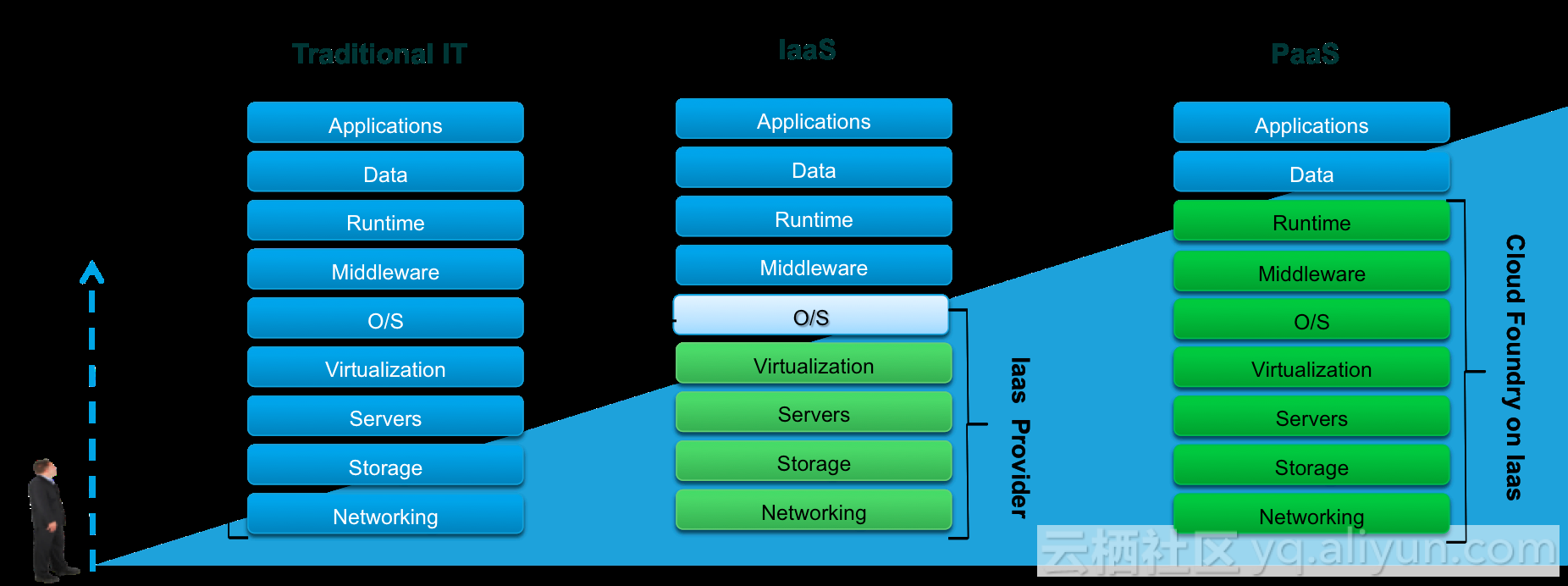
Cloud Foundry组件(v2版本)
Cloud Foundry是由相对独立的多个模块构成的分布式系统,每个模块单独存在和运行,各模块之间通过消息机制进行通信。
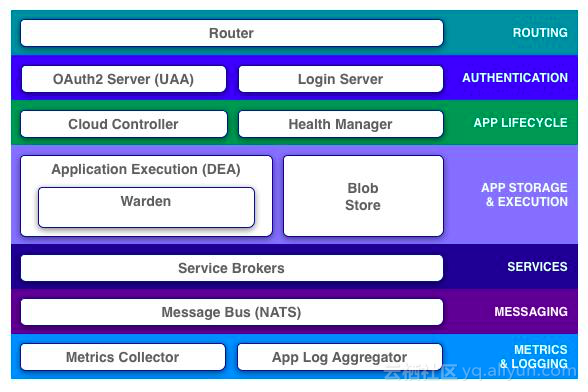
Cloud Foundry目前最新的架构为v3版本,各个组件的功能,官网有详细的介绍,这边不再赘述。
参考:http://docs.cloudfoundry.org/concepts/architecture/
阿里云上部署Cloud Foundry实战
环境说明:
(本文使用软件版本和环境的说明,涉及到的概念下文会详细解释)
阿里云region:华东1
ruby 版本:2.3.0
bosh-init 版本:0.0.96
Bosh CLI 版本:1.3262.4.0
CF CLI 版本:6.21.0
部署流程
在阿里云上部署Cloud Foundry,部署流程分为三大部分,分别为:
1. 开通阿里云环境资源:包括准备阿里云账号,开通相关云产品资源等等
2. 部署Bosh:安装bosh-init,使用bosh-init部署Bosh
3. 部署Cloud Foundry:使用Bosh部署Cloud Foundry
本文后续内容会根据三步部署流程详细讲述。
一、开通阿里云环境资源
Cloud Foundry需要部署在VPC环境下,需要开通VPC资源,并创建虚拟交换机,规划好部署Cloud Foundry的内网网段。
同时,也需要创建一对Access Key ID和Access Key Secret,也可以使用现有的Access Key ID和Access Key Secret对。
创建专有网络VPC
创建虚拟交换机
可用区和网段没有限制,方便起见,笔者选择了华东1可用区E,网段为10.0.0.0/25
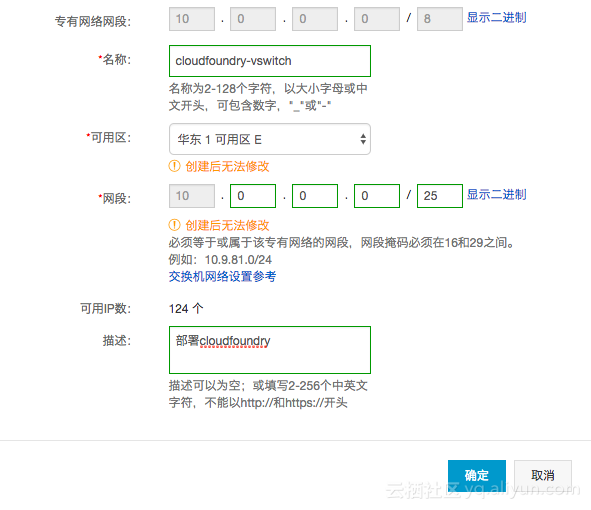
创建Access Key ID和Access Key Secret
二、部署Bosh
Bosh介绍
Bosh是一个统一了平台即服务软件(如Cloud Foundry)的发布、部署和生命周期管理的自动化配置部署工具。简单的说,Bosh的作用之一就是部署Cloud Foundry,部署Cloud Foundry之前,首先要部署Bosh。
在讲怎么在阿里云上部署Bosh之前,首先需要了解Bosh中的几个基本概念。
Bosh官网参考:https://bosh.io/docs
CPI
CPI全称Cloud Platform Interface,是Bosh对外开放的一组标准化接口,在IaaS上部署Bosh,需要实现这组接口,Bosh用CPI对IaaS的资源进行管理,包括创建虚拟机,释放虚拟机,等等......
在阿里云上部署Bosh,需要用阿里云OpenAPI实现CPI。
CPI参考:https://bosh.io/docs/cpi-api-v1.html
CPI API v1完整接口列表:
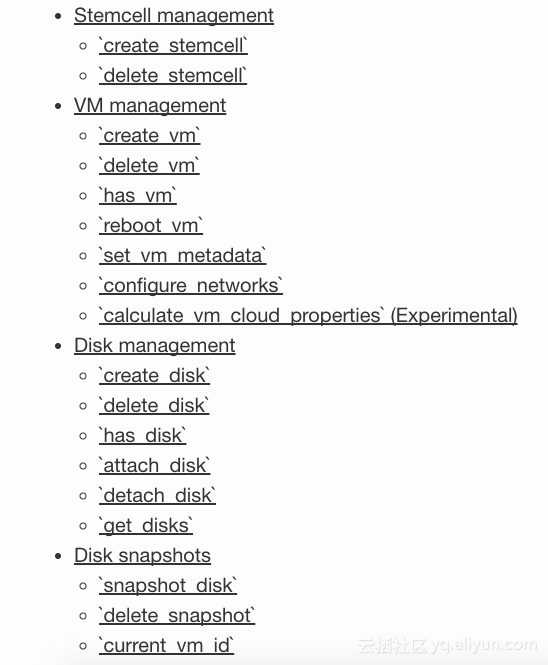
bosh-init
bosh-init是Bosh官网提供的一个开源工具,它的作用就是用来部署Bosh。
bosh-init参考:https://bosh.io/docs/using-bosh-init.html
stemcell
stemcell是虚拟机镜像,预装了部署过程中需要的组件(其中最重要的组件是Bosh Agent),官方的描述是:A stemcell is a versioned Operating System image wrapped with IaaS specific packaging. Bosh用CPI创建的虚拟机,用stemcell镜像启动。
stemcell参考:https://bosh.io/docs/stemcell.html
release
release是Bosh中一个安装部署包的概念,包含了所有安装分布式系统需要的源代码、配置文件、脚本文件等等,官网描述为:A release is a versioned collection of configuration properties, configuration templates, start up scripts, source code, binary artifacts, and anything else required to build and deploy software in a reproducible way.
例如,安装Bosh,我需要一个Bosh-release;用Bosh安装Cloud Foundry,我需要一个cf-release。
所有release都有版本迭代,都可以在Bosh官网找到。
release参考:https://bosh.io/docs/release.html
Deployment
一个Deployment是一组VM的集合,由指定的stemcell镜像启动,用于部署对应release的系统。官方描述为:A deployment is a collection of VMs, built from a stemcell, that has been populated with specific releases and disks that keep persistent data. These resources are created based on a manifest file in the IaaS and managed by the BOSH Director, a centralized management server.
在Bosh的概念里,一个Deployment对应一个release,Deployment的具体配置,写在Deployment manifest里,在部署过程中提供。
Deployment参考:https://bosh.io/docs/deployment.html
阿里云上部署Bosh
1. 创建ECS
通过阿里云控制台创建一个ECS(包年包月、按量均可),用于安装bosh-init。方便起见,下文以bosh-init指代这台ECS。
推荐配置:
规格:2核4G及以上
镜像:Ubuntu 14.04 64位
系统盘:40GB以上,高效云盘
网络类型:VPC实例,选择在上一步创建好的VPC和虚拟交换机,公网IP可以选择不分配。
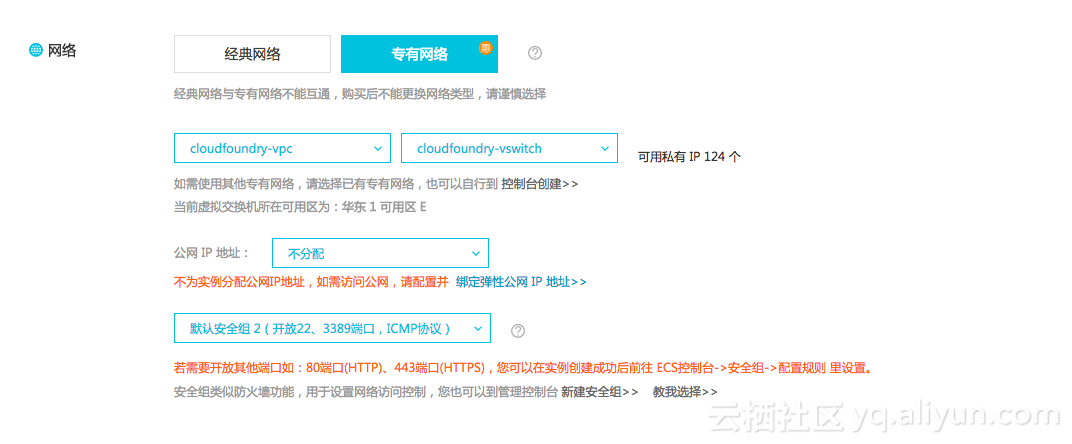
2. 给bosh-init配置公网IP
因为bosh-init是VPC实例,需要给bosh-init绑定弹性公网IP,让bosh-init可以通过公网访问。
按需购买弹性公网IP,并给bosh-init绑定弹性公网IP
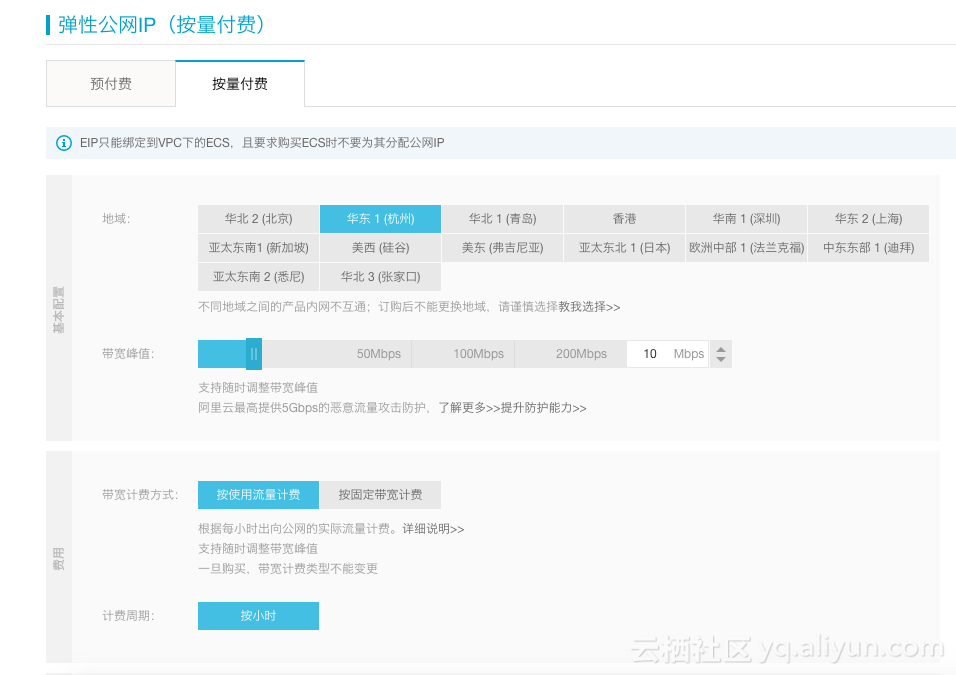
3. 安装bosh-init
参考文档:http://bosh.io/docs/install-bosh-init.html
- SSH登陆到bosh-init这台ECS
- 下载bosh-init,下载地址见:http://bosh.io/docs/install-bosh-init.html
- 执行权限
chmod +x ~/Downloads/bosh-init-* - 移动到/usr/local/bin
sudo mv ~/Downloads/bosh-init-* /usr/local/bin/bosh-init - 验证安装成功
bosh-init -v - 安装对应环境,笔者使用的是Ubuntu的机器
sudo apt-get install -y build-essential zlibc zlib1g-dev ruby ruby-dev openssl libxslt-dev libxml2-dev libssl-dev libreadline6 libreadline6-dev libyaml-dev libsqlite3-dev sqlite3 - 确保已经安装Ruby 2+环境

4. 下载bosh-release
bosh-release是开源的,可以从Bosh官网下载:
https://bosh.io/releases/github.com/cloudfoundry/bosh?all=1
5. 下载cpi-release
CPI近期会开源,请关注:
https://github.com/alibaba/opstools
6. 配置manifest
根据以下模板,新建一个manifest文件bosh.yml,在模板中填充阿里云资源相关的内容。
---
name: bosh
releases:
- name: bosh
url: file:///root/downloads/bosh-255.3.tgz
- name: bosh-aliyun-cpi
url: file:///root/downloads/bosh-aliyun-cpi.tgz
resource_pools:
- name: vms
network: private
cloud_properties:
instance_type: ecs.n4.large # <--- 实例规格
networks:
- name: private
type: manual
subnets:
- range: 10.0.0.0/8
gateway: 10.0.0.1
cloud_properties: {
SecurityGroupId: SECURITY_GROUP_ID, # <--- 安全组ID
VSwitchId: VSWITCH-ID # <--- 虚拟交换机ID
}
- name: public
type: vip
jobs:
- name: bosh
instances: 1
templates:
- {name: nats, release: bosh}
- {name: redis, release: bosh}
- {name: postgres, release: bosh}
- {name: blobstore, release: bosh}
- {name: director, release: bosh}
- {name: health_monitor, release: bosh}
- {name: registry, release: bosh}
- {name: aliyun_cpi, release: bosh-aliyun-cpi}
resource_pool: vms
networks:
- name: private
static_ips: [10.0.0.2] # <--- ECS内网IP
default: [dns, gateway]
- name: public
static_ips: [STATIC_IP] # <--- 弹性公网IP
properties:
nats: &nats
address: 127.0.0.1
user: nats
password: nats-password
redis:
listen_address: 127.0.0.1
address: 127.0.0.1
password: redis-password
postgres: &db
listen_address: 127.0.0.1
host: 127.0.0.1
user: postgres
password: postgres-password
database: bosh
adapter: postgres
registry: ®istry
address: 127.0.0.1
host: 127.0.0.1
db: *db
http: {user: admin, password: admin, port: 25777}
username: admin
password: admin
port: 25777
blobstore: &blobstore
address: 127.0.0.1
port: 25250
provider: dav
director: {user: director, password: director-password}
agent: {user: agent, password: agent-password}
director:
address: 127.0.0.1
name: my-bosh
db: *db
cpi_job: aliyun_cpi
max_threads: 10
user_management:
provider: local
local:
users:
- {name: admin, password: admin}
- {name: hm, password: hm-password}
hm:
director_account: {user: hm, password: hm-password}
resurrector_enabled: true
aliyun: &aliyun
access_key_id: ACCESS_KEY_ID # <--- 阿里云 Access Key ID
access_key: ACCESS_KEY # <--- 阿里云 Access Key Secret
default_key_name: bosh
default_security_groups: [bosh]
region_id: cn-hangzhou # <--- 阿里云 Region
ntp: &ntp [0.pool.ntp.org, 1.pool.ntp.org]
cloud_provider:
template: {name: aliyun_cpi, release: bosh-aliyun-cpi}
mbus: "https://mbus:mbus-password@10.0.0.2:6868" # <--- ECS内网IP
properties:
aliyun: *aliyun
agent:
mbus: "nats://nats:nats-password@10.0.0.2:4222" # <--- ECS内网IP
blobstore:
provider: "dav"
options:
endpoint: "http://10.0.0.2:25250" # <--- ECS内网IP
user: "agent"
password: "agent-password"
blobstore: {provider: local, path: /var/vcap/micro_bosh/data/cache}
ntp: *ntp
nats: *nats
registry: *registry
blobstore: *blobstore
7. 部署Bosh
执行部署命令:
bosh-init deploy bosh.yml
8. 验证Bosh
我们用Bosh CLI验证Bosh是否部署成功。
Bosh CLI是Bosh官方提供的,用于和Bosh交互的命令行工具。在部署完成Bosh之后,用Bosh CLI和Bosh交互,执行相关命令,进行下一步Cloud Foundry的部署。
安装Bosh CLI
Bosh CLI可以安装在任意一台ECS上,或者本地主机上。
安装Bosh CLI:https://bosh.io/docs/bosh-cli.html
验证Bosh
执行Bosh CLI命令:
bosh target 10.0.0.2
笔者的Bosh CLI安装在同一个安全组的ECS上,因此可以和部署Bosh的ECS进行内网通讯,直接通过内网IP,target到Bosh。如果需要通过公网通讯,需要给部署Bosh的ECS绑定弹性公网IP,或者使用NAT网关产品,保证网络能通。
如图显示,成功连接到目标Bosh,验证Bosh成功。
bosh releases、bosh stemcells这两条命令,使用Bosh部署Cloud Foundry的时候会用到,我们下节细讲。

三、部署Cloud Foundry
基本概念
首先我们也需要了解用Bosh部署Cloud Foundry过程中的几个基本概念。
Bosh CLI
上一节讲到,我们需要使用已经部署成功的Bosh来部署Cloud Foundry,通过Bosh CLI和Bosh进行交互,执行相关部署命令。因此,使用Bosh部署Cloud Foundry之前,首先需要了解Bosh CLI命令的使用。
Bosh CLI几个基本命令:
1.连接到指定Bosh
bosh target [DIRECTOR_URL]
2.列出当前release仓库中所有的release
bosh releases
3.上传release到Bosh的release仓库,只有仓库里的release可以用于部署
bosh upload release [RELEASE_FILE]
4.列出当前stemcell仓库里的所有stemcell
bosh stemcells
5.上传stemcell到Bosh的stemcell仓库,只有仓库里的stemcell可以用于部署
bosh upload stemcell STEMCELL_PATH
bosh upload stemcell STEMCELL_URL
6.列出当前所有的Deployment
bosh deployments
7.列出当前Deployment的信息
bosh deployment
8.切换到指定manifest对应的Deployment
bosh deployment [MANIFEST_PATH]
9.执行部署当前Deployment
bosh deploy
Bosh CLI官网参考:http://bosh.io/docs/sysadmin-commands.html
CPI
在上一步部署Bosh中,已经部署好的Bosh中已经包含了CPI组件,因此在部署Cloud Foundry中不再需要CPI-release
stemcell
和上一步部署Bosh中类似。
cf-release
Cloud Foundry官网提供的压缩包,包含Cloud Foundry所有组件的源码。
Deployment manifest
Deployment的配置文件,主要描述了用哪个stemcell,用哪个cf-release,需要部署哪些CF组件,需要多少VM,VM规格信息,VM的IP信息,具体哪个VM部署哪个CF组件,等等......
部署Cloud Foundry流程
1. 下载cf-release
cf-release是开源的,可以从Bosh官网下载:
http://bosh.io/releases/github.com/cloudfoundry/cf-release?all=1
2. 登陆到安装有Bosh CLI的机器
我们需要用Bosh CLI和Bosh进行交互,执行部署Cloud Foundry命令
3. 用Bosh CLI连接到部署好的Bosh
bosh target 10.0.0.2
4. 上传cf-release
上传下载完成的cf-release,执行以下Bosh CLI命令:
bosh upload release <release_file>
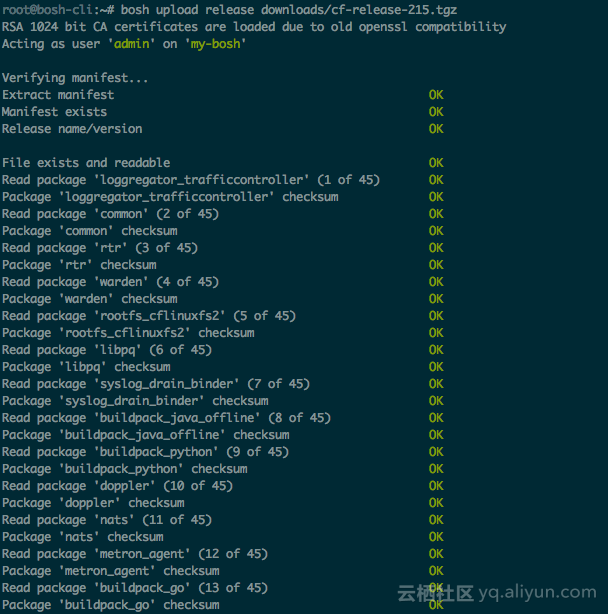
5. 配置manifest
根据以下模板,新建一个manifest文件cf.yml,在模板中填充阿里云资源相关的内容。
---
name: ali-cf
director_uuid: BOSH_DIRECTOR_UUID # <--- Bosh Director UUID
releases:
- {name: cf, version: 215}
networks:
- name: private
type: manual
subnets:
- range: 10.0.0.0/8
gateway: 10.0.0.1
#dns: [10.0.0.2]
reserved: ["10.0.0.2"]
static: ["10.0.0.3 - 10.0.0.100"]
cloud_properties:
SecurityGroupId: SECURITY_GROUP_ID # <--- 安全组ID
VSwitchId: VSWITCH_ID # <--- 虚拟交换机ID
resource_pools:
- name: small_ecs
network: private
cloud_properties:
instance_type: ecs.n1.tiny # <--- 实例规格
compilation:
workers: 1
network: private
reuse_compilation_vms: true
cloud_properties:
instance_type: ecs.n1.medium # <--- 实例规格
update:
canaries: 1
max_in_flight: 1
serial: false
canary_watch_time: 30000-600000
update_watch_time: 5000-600000
jobs:
- name: nats
instances: 1
resource_pool: small_ecs
templates:
- {name: nats, release: cf}
networks:
- name: private
static_ips: [10.0.0.20] # <--- ECS内网IP
- name: nfs
instances: 1
persistent_disk: 50
resource_pool: small_ecs
templates:
- {name: debian_nfs_server, release: cf}
networks:
- name: private
static_ips: [10.0.0.21] # <--- ECS内网IP
- name: postgres
instances: 1
persistent_disk: 50
resource_pool: small_ecs
templates:
- {name: postgres, release: cf}
networks:
- name: private
static_ips: [10.0.0.22] # <--- ECS内网IP
update:
serial: true
- name: cloud_controller
instances: 2
resource_pool: small_ecs
templates:
- {name: cloud_controller_ng, release: cf}
- {name: cloud_controller_worker, release: cf}
- {name: cloud_controller_clock, release: cf}
- {name: nfs_mounter, release: cf}
networks:
- name: private
static_ips: [10.0.0.23, 10.0.0.33] # <--- ECS内网IP
propertis:
nfs_server:
address: 10.0.0.21
allow_from_entries: [10.0.0.0/24]
- name: hm9000
instances: 1
resource_pool: small_ecs
templates:
# - {name: consul_agent, release: cf}
- {name: hm9000, release: cf}
# - {name: metron_agent, release: cf}
- {name: route_registrar, release: cf}
networks:
- name: private
static_ips: [10.0.0.24] # <--- ECS内网IP
- name: doppler_z1
instances: 1
resource_pool: small_ecs
templates:
- {name: doppler, release: cf}
networks:
- name: private
properties:
doppler: {zone: z1}
doppler_endpoint:
shared_secret: PASSWORD
- name: loggregator_trafficcontroller_z1
instances: 1
resource_pool: small_ecs
templates:
- {name: loggregator_trafficcontroller, release: cf}
- {name: metron_agent, release: cf}
- {name: route_registrar, release: cf}
networks:
- name: private
properties:
traffic_controller: {zone: z1}
route_registrar:
routes:
- name: doppler
registration_interval: 20s
port: 8081
uris:
- "doppler.REPLACE_WITH_SYSTEM_DOMAIN"
- name: loggregator
registration_interval: 20s
port: 8080
uris:
- "loggregator.REPLACE_WITH_SYSTEM_DOMAIN"
- name: uaa
instances: 1
resource_pool: small_ecs
templates:
- {name: uaa, release: cf}
networks:
- name: private
static_ips: [10.0.0.25] # <--- ECS内网IP
properties:
login:
catalina_opts: -Xmx768m -XX:MaxPermSize=256m
uaa:
admin:
client_secret: PASSWORD
batch:
password: PASSWORD
username: batch_user
cc:
client_secret: PASSWORD
scim:
userids_enabled: false
users:
- cps@aliyun.com|Cps123456|scim.write,scim.read,openid,cloud_controller.admin
uaadb:
address: 10.0.0.22 # <--- postgres组件内网IP
databases:
- {name: uaadb, tag: uaa}
db_scheme: postgresql
port: 5524
roles:
- {name: uaaadmin, password: uaa-password, tag: admin}
- name: router
instances: 1
resource_pool: small_ecs
templates:
- {name: gorouter, release: cf}
networks:
- name: private
static_ips: [10.0.0.27] # <--- ECS内网IP
properties:
dropsonde: {enabled: true}
- name: dea_ng
instances: 1
resource_pool: small_ecs
templates:
- {name: dea_next, release: cf}
networks:
- name: private
static_ips: [10.0.0.26] # <--- ECS内网IP
properties:
networks: {apps: private}
app_domains: [DOMAIN] # <--- domain
domain: DOMAIN # <--- domain
system_domain: DOMAIN # <--- domain
system_domain_organization: default_organization
cc:
allow_app_ssh_access: false
bulk_api_password: PASSWORD
db_encryption_key: PASSWORD
default_running_security_groups: [public_networks, dns]
default_staging_security_groups: [public_networks, dns]
install_buildpacks:
- {name: java_buildpack, package: buildpack_java}
- {name: ruby_buildpack, package: buildpack_ruby}
- {name: nodejs_buildpack, package: buildpack_nodejs}
- {name: go_buildpack, package: buildpack_go}
- {name: python_buildpack, package: buildpack_python}
- {name: php_buildpack, package: buildpack_php}
- {name: staticfile_buildpack, package: buildpack_staticfile}
- {name: binary_buildpack, package: buildpack_binary}
internal_api_password: PASSWORD
quota_definitions:
default:
memory_limit: 102400
non_basic_services_allowed: true
total_routes: 1000
total_services: -1
security_group_definitions:
- name: private
rules: []
srv_api_uri: http://api.DOMAIN # <--- domain
staging_upload_password: PASSWORD
staging_upload_user: staging_upload_user
ccdb:
address: 10.0.0.22 # <--- postgres组件内网IP
databases:
- {name: ccdb, tag: cc}
db_scheme: postgres
port: 5524
roles:
- {name: ccadmin, password: cc-password, tag: admin}
databases:
databases:
- {name: ccdb, tag: cc, citext: true}
- {name: uaadb, tag: uaa, citext: true}
port: 5524
roles:
- {name: ccadmin, password: cc-password, tag: admin}
- {name: uaaadmin, password: uaa-password, tag: admin}
dea_next:
advertise_interval_in_seconds: 5
heartbeat_interval_in_seconds: 10
etcd:
machines: [10.0.0.24] # <--- hm9000组件内网IP
hm9000:
url: http://hm9000.DOMAIN # <--- domain
nats:
machines: [10.0.0.20] # <--- nats组件内网IP
password: nats-password
port: 4222
user: nats
nfs_server:
no_root_squash: true
address: 10.0.0.21 # <--- nfs组件内网IP
allow_from_entries: [10.0.0.0/24]
uaa:
no_ssl: true
clients:
gorouter:
authorities: clients.read,clients.write,clients.admin,route.admin,route.advertise
authorized-grant-types: client_credentials,refresh_token
scope: openid,cloud_controller_service_permissions.read
secret: PASSWORD
cloud_controller_username_lookup:
authorities: scim.userids
authorized-grant-types: client_credentials
secret: PASSWORD
login:
authorities: oauth.login,scim.write,clients.read,notifications.write,critical_notifications.write,emails.write,scim.useridsassword.write
authorized-grant-types: authorization_code,client_credentials,refresh_token
override: true
redirect-uri: http://login.DOMAIN:8080/auth/cloudfoundry/callback # <--- domain
scope: openid,oauth.approvals,cloud_controller.read,cloud_controller.write
secret: PASSWORD
url: http://uaa.DOMAIN # <--- domain
6. 新建cf.yml对应的Deployment
bosh deployment cf.yml
7. 执行部署命令
bosh deploy
8. 验证Cloud Foundry
部署完成之后,执行以下命令,查看Cloud Foundry部署详情:
bosh vms
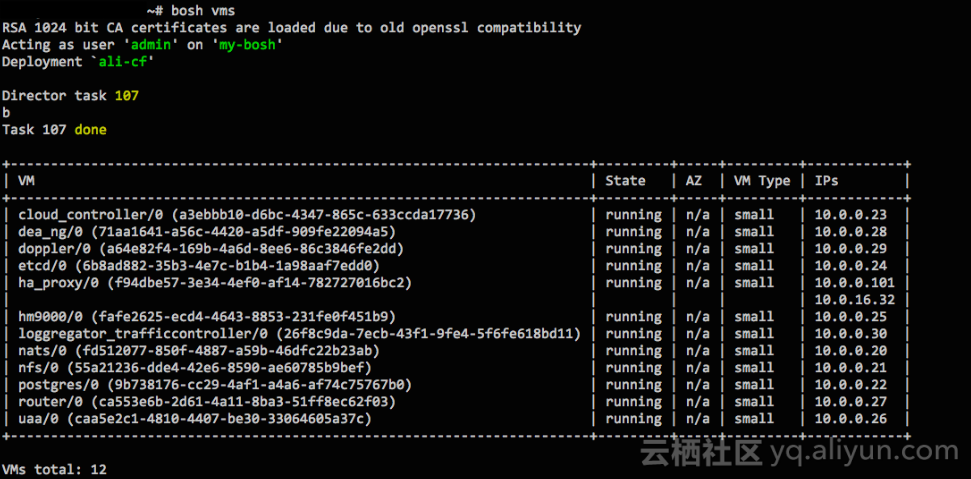
至此,Cloud Foundry在阿里云上部署成功。







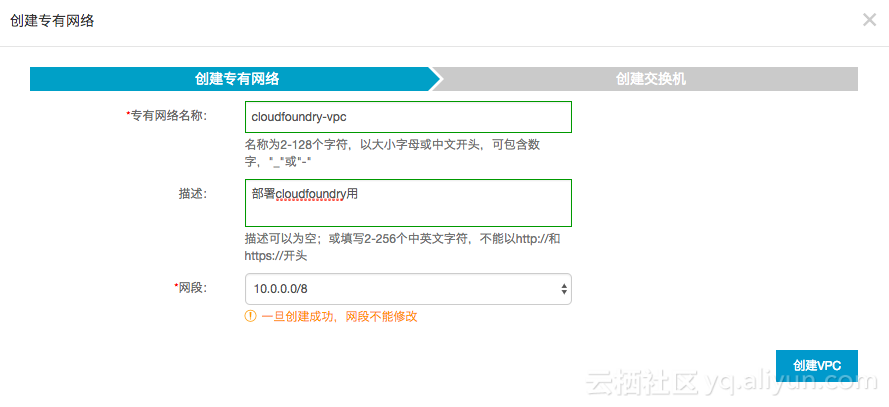


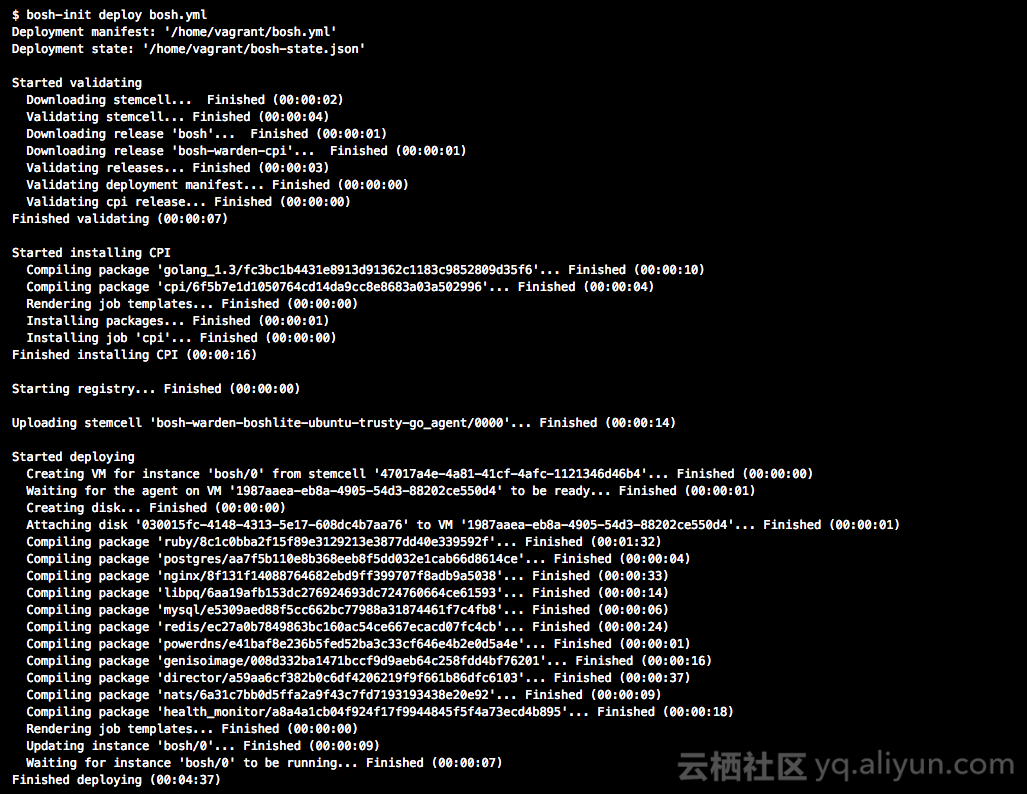















 6377
6377











 被折叠的 条评论
为什么被折叠?
被折叠的 条评论
为什么被折叠?








